

The Nagual – Vision of the Nagual. “A nagual is empty.
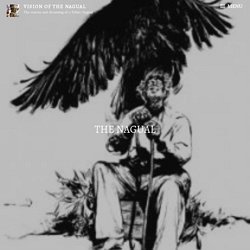
That emptiness doesn’t reflect the world, it reflects infinity. A nagual has no boisterousness on his part, or assertions about the self. There is not a speck of a need to have either grievances or remorse. His is the emptiness of a warrior-traveler, seasoned to the point where he doesn’t take anything for granted. A warrior-traveler who doesn’t underestimate or overestimate anything.
The word nagual (nahual) is derived from the ‘Nahuatl language. The person who is to receive his nagual traditionally goes to an isolated spot and sleeps. Great Beasts of Legend: Monsters of the Maya Cosmos. Chilam Balam: Introduction. Sacred Texts Native American Maya Index Previous Next p. 3.

Chilam Balam Index. Sacred Texts Native American Maya Title PagePrefaceContentsPlate 1List of IllustrationsIntroduction Translation.
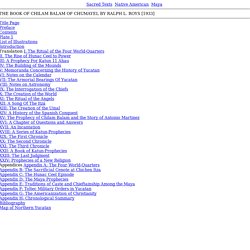
General History of the Things of New Spain by Fray Bernardino de Sahagún: The Florentine Codex. Historia general de las cosas de nueva España (General history of the things of New Spain) is an encyclopedic work about the people and culture of central Mexico compiled by Fray Bernardino de Sahagún (1499–1590), a Franciscan missionary who arrived in Mexico in 1529, eight years after completion of the Spanish conquest by Hernan Cortés.
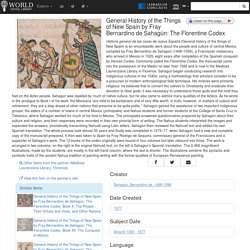
Commonly called the Florentine Codex, the manuscript came into the possession of the Medici no later than 1588 and is now in the Medicea Laurenziana Library in Florence. Sahagún began conducting research into indigenous cultures in the 1540s, using a methodology that scholars consider to be a precursor to modern anthropological field technique. His motives were primarily religious: he believed that to convert the natives to Christianity and eradicate their devotion to false gods, it was necessary to understand those gods and the hold they had on the Aztec people. Kabbalah of the Mayan Mysteries, a book by Samael Aun Weor. Every planet develops seven Root Races and seven subraces.

Our planet Earth already developed five Root Races; it needs to develop two more Root Races. After the seven Root Races, the planet Earth, already transformed by cataclysms over the course of millions of years, will become a new moon. This entire Earth’s devolving and evolving life came from the Moon. When the great life abandoned the Moon, it died; it became a desert. The Moon also developed seven Root Races and each one of them developed seven subraces. The Mayan Peace Talks: The 5 Gardens of Eden on Earth. 4th June 2016 By Xchelita (“Little Rainbow”) a.k.a.
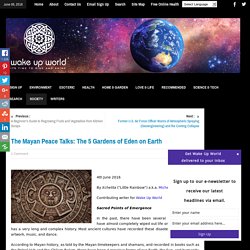
Michelle Recchia Contributing writer for Wake Up World Sacred Points of Emergence In the past, there have been several catastrophes that have almost completely wiped out life on our planet. The Elders and the Hills: Animism and Cosmological Re-Creation among the Q'eqchi' Maya in Chisec, Guatemala. Animism and Cosmologial Re-Creation among the Q’eqchi’ Maya in Chisec, Guatemala Within the context of post-war Maya cultural resurgence and the recent introduction of non-indigenous elements Stefan Permanto examines cos-mological notions and ritual practices among a group of elderly Q’eqchi’ men and women in the municipality of Chisec, Alta Verapaz, Guatemala.
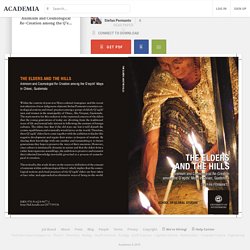
The main motive for this endeavor is the expressed concern of the elders that the young generations of today are diverting from the traditional ways of life and instead take interest in following the customs of foreign cultures. Cosmic equilibrium and eventually wreak havoc in the world. These Q’eqchi’ elders have come together with the ambition to hinder this negative development and regain their status as keepers of wisdom. Since culture is intrinsically dynamic in nature and that the elders form a. The Mythic and Heroic Sagas of the Kichés of Central America. Excerpt from: The Mythic and Heroic Sagas of the Kichés of Central America by Lewis Spence Published by David Nutt, at the Sign of the Phoenix, Long Acre, London THE "Popol Vuh" is the New World's richest mythological mine.
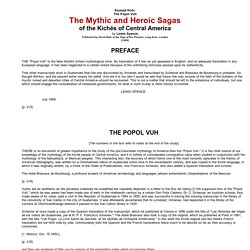
That other manuscripts exist in Guatemala than the one discovered by Ximenes and transcribed by Scherzer and Brasseur de Bourbourg is probable. {p. 213} According to the Sacred Book of the Maya, Otherworldly Beings Created Mankind. These beings who created mankind are referred to in the Popol Vuh as “the Creator, the Former, the D...
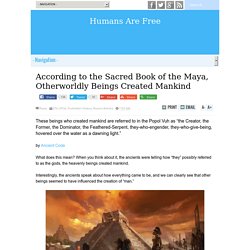
These beings who created mankind are referred to in the Popol Vuh as “the Creator, the Former, the Dominator, the Feathered-Serpent, they-who-engender, they-who-give-being, hovered over the water as a dawning light.” by Ancient Code What does this mean? The White Alien Gods of Mesoamerica: Viracocha, Quetzalcoatl and Kukulkan. Popol Vuh - The Sacred Book of The Mayas. The Popol Vuh (K'iche' for "Council Book" or "Book of the Community"; Popol Wu'uj in modern spelling; is a book written in the Classical Quiché language containing mythological narratives and a genealogy of the rulers of the Post-Classic Quiché Maya kingdom of highland Guatemala.
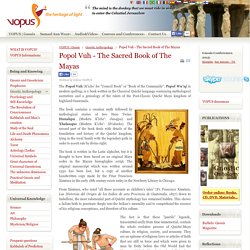
The book contains a creation myth followed by mythological stories of two Hero Twins: Hunahpu (Modern K'iche': Junajpu) and Xbalanque (Modern K'iche': Xb‘alanke). THE INCA CREATION MYTH. ATLANTEAN GARDENS: Quetzalcoatl, Kukulkan, Viracocha, Votan, Gucumatz. When the Spanish conquistadors and the Catholic fathers first arrived on the shores of Mexico, and in South America, and when the English and French colonizers and missionaries first penetrated Canada and United States, they received from the native Indians tribes scattered in the western hemisphere several versions of a tradition of a "Bearded God" who had in the distant past visited their ancestors, taught them their culture, and mysteriously disappeared, but who would eventually return to them.
Although the traditions from the different Indian groups regarding the "Bearded God" do not agree in every detail, there being a variety of versions, yet in the principal points these Indian traditions, from Canada to Chile, have a close resemblance to one another. The Feathered Serpent God is one of the great mysteries of many ancient cultures. Legends all seem to agree that Quetzalcoatl was tall and light-skinned, with blonde hair, blue eyes, and a beard. ATLANTEAN GARDENS: Maya ruler of Palenque, Pakal the Great. The Mayan ruler of Palenque, also known as Pakal the Great, ascended the throne as a child and went on to rule for sixty-eight years.
Lord Pakal has come down to posterity as the best-known of Mayan kings, albeit his fame derives mostly from his magnificent burial. An interesting inscription is found on the cover stone, which weighs over 5 tons. ATLANTEAN GARDENS: August 2014. A mysterious set of massive monuments in Peru make up the oldest solar observatory in the Americas, according to a new study. The 2,300-year-old Thirteen Towers of Chankillo were used for marking the sun's position throughout the year—an activity that was part of the sun-worshipping culture of the Inca, scientists recently announced.
The large stone towers are arranged in a line along a ridge near Chankillo, a walled hilltop ruin north of Lima. Mayan Mythology – FREE Mayan Mythology information. The Mayan civilization flourished in Mesoamerica from around 300 b.c. until the Spanish conquest of the early a.d. 1500S. The mythology of the Maya had many elements in common with those of other civilizations of the region. But the Maya developed their own variation of the Mesoamerican pantheon of gods and goddesses, the stories about them, and the image of the universe and the place of humans in it.
In Mayan mythology, the gods and heroes had many different names and appearances, stories occurred in varying forms, and scenes and figures changed and shifted with confusing rapidity. Beneath this seeming confusion, though, lay a sense that the universe was an orderly, structured place and that proper behavior toward the gods played an important role in maintaining its harmony and balance. Background and Sources. The Olmec pantheon probably included deities of rain, corn, and fire, as well as a feathered serpent god. Mayan Mythology - Gods and Goddesses. Mayan Mythology [Go to 9:45] The Underground World of Xibalba [Go to 31:48] Maya mythology refers to the pre-Columbian Maya civilization's extensive polytheistic religious beliefs. These beliefs had most likely been long-established by the time the earliest-known distinctively Maya monuments had been built and inscriptions depicting their deities recorded, considerably pre-dating the 1st millennium BC.
Over the succeeding millennia this intricate and multi-faceted system of beliefs was extended, varying to a degree between regions and time periods, but maintaining also an inherited tradition and customary observances. Despite the ca. early 10th century "Terminal collapse", during which Maya monument construction and inscription recording effectively ceased over large areas and many centers were subsequently abandoned, the Maya peoples themselves endured and continued to maintain their assorted beliefs and traditions. A fifth 'direction', the "center", also formed a part of this scheme. Maya mythology. Mayan Mythology - Myth Encyclopedia - god, names, ancient, tree, war, world, creation, Native American. The Mayan civilization flourished in Mesoamerica from around 300 B .